This article needs additional citations for verification .(March 2008) |
William George Chard (1812 - September 19, 1877) was a California pioneer.
This article needs additional citations for verification .(March 2008) |
William George Chard (1812 - September 19, 1877) was a California pioneer.
William George Chard was born in Columbia County, New York in 1812. He came to California via New Mexico with trappers Cyrus Alexander and Lemuel Carpenter, arriving in Los Angeles in 1832. He travelled to Santa Barbara, and Monterey. Chard married Maria Esteven Robles (1823–1871) in 1837. [1] In 1844, he was granted the Rancho Las Flores Mexican land grant in present-day Tehama County, California. Chard was Superintendent of the New Almaden quicksilver mine south of San Jose until 1846.
He died September 19, 1877.

Tehama County is a county located in the northern part of the U.S. state of California. As of the 2010 census, the population was 63,463. The county seat and largest city is Red Bluff.
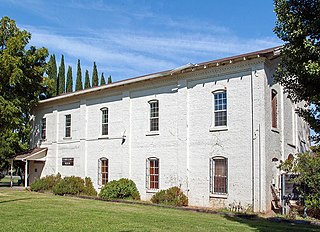
Tehama is a city in Tehama County, California, United States. The population was 418 at the 2010 census, down from 432 at the 2000 census.
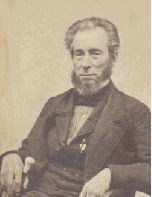
William Brown Ide was an American pioneer who headed the short-lived California Republic in 1846.

Josiah Belden, known in Spanish as Josías Belden, was a Californian politician and trader. He was born in Connecticut, eventually emigrating to Alta California. In California, he became a Mexican citizen, a prominent trader, and a rancho grantee.

William Samuel Henson was a British-born pre-Wright brothers aviation pioneer, engineer and inventor. He is best known for his work on the aerial steam carriage alongside John Stringfellow.

William Wolfskill (1798–1866) was an American-Mexican pioneer, cowboy, and agronomist in Los Angeles, California beginning in the 1830s. He had earned money for land in a decade as a fur trapper near Santa Fe, New Mexico, where he had become a Mexican citizen. This enabled him to own land in California.
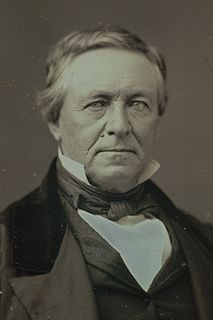
John Marsh, later known in Spanish as Don Juan Marsh, was a physician, ranchero, and linguist in California when it was still part of the Republic of Mexico. Born in Massachusetts, Marsh immigrated to California in 1836, where he became a Mexican citizen. He was baptized as Roman Catholic in order to buy land, and acquired the vast land grant of Rancho Los Méganos in Contra Costa. He became one of the wealthiest ranchers in California, and was among the highly influential men who worked to gain United States statehood after Mexico ceded this area following its defeat in the Mexican-American War.
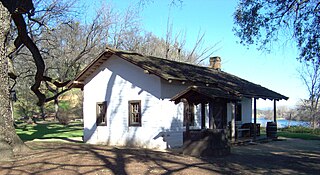
William B. Ide Adobe State Historic Park is a California State Historic Park located on the west bank of the Sacramento River, a mile north of Red Bluff in Tehama County, California. It is in the Sacramento Valley of Northern California.

David W. Alexander was an early California politician and pioneer in Los Angeles County, California. He was on the Board of Supervisors in 1853 and 1854, and in 1855 he was elected the third sheriff for the county.

George Calvert Yount, later known by his Spanish name Don Jorge Concepción Yount, was a Californian ranchero, fur trapper, and entrepreneur. Born in North Carolina, he later emigrated to Alta California, where he became a Mexican citizen and acquired substantial property holdings in the Napa Valley, largely due to the influence of his friendship with General Mariano G. Vallejo. The city of Yountville, California is named for him.
Rancho Rio de los Molinos was a 22,172-acre (89.73 km2) Mexican land grant in present-day Tehama County, California given in 1844 by Governor Manuel Micheltorena to Albert Gallatin Toomes. "Rio de los Molinos" means "River of the Mills". The long narrow grant extended along the east side of the Sacramento River from Dye Creek on the north, to Toomes Creek on the south, and encompassed present-day Los Molinos.
Rancho Las Flores was a 13,316-acre (53.89 km2) Mexican land grant in present-day Tehama County, California given in 1844 by Governor Manuel Micheltorena to William Chard. The name means "ranch of the flowers". The grant was on the west side of the Sacramento River and was bounded by Rancho Barranca Colorado and Coyote Creek on the north and by Rancho Saucos and Elder Creek on the south, and encompassed present-day Gerber and Proberta.
Rancho Saucos was a 22,212-acre (89.89 km2) Mexican land grant in present-day Tehama County, California given in 1844 by Governor Manuel Micheltorena to Robert H. Thomes. The name means "Ranch of the Elder trees". The grant extended along the west side of the Sacramento River from Elder Creek and Rancho Las Flores on the north to Thomes Creek on the south, and encompassed present-day Tehama.
Rancho Primer Cañon o Rio de Los Berrendos was a 26,637-acre (107.80 km2) Mexican land grant in present day Tehama County, California given in 1844 by Governor Manuel Micheltorena to Job Francis Dye. Rio de Los Berrendos means River of the Antelopes. The grant was on the east side of the Sacramento River and was bounded by Antelope Creek on the north and Rancho Rio de los Molinos and Dye Creek on the south.
Rancho Bosquejo was a 22,206-acre (89.86 km2) Mexican land grant in present-day Tehama County, California given in 1844 by Governor Manuel Micheltorena to Peter Lassen. The name means "Wooded Ranch" in Spanish. The grant extended along the east bank of the Sacramento River south of Rancho Rio de los Molinos and Toomes Creek, and encompassed present day Vina on Deer Creek.
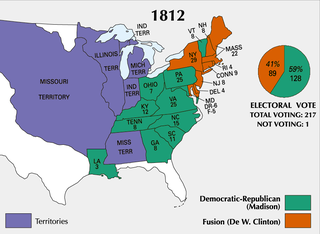
The following is a partial list of events from the year 1812 in the United States. After years of increasing tensions, the United States declares war on the British Empire, starting the War of 1812.
Rancho Capay was a 44,388-acre (179.63 km2) Mexican land grant in present-day Tehama County and Glenn County, California given in 1844 by Governor Manuel Micheltorena to Maria Josefa Soto. The name comes from the Wintun word meaning stream, and refers to Stony Creek. The grant extended two leagues in width and five leagues along the west side of the Sacramento River from Thomes Creek and Rancho Saucos on the north to Stony Creek on the south, and encompassed present day Hamilton City and Monroeville.

George William Lord was an Australian pastoralist, businessman and politician. He was a member of the New South Wales Legislative Council from 1877 until his death. He was also a member of the New South Wales Legislative Assembly between 1856 and 1877. Lord was the Colonial Treasurer in the third government of James Martin.
Chard is a surname. Notable people with the name include:
The Superior Court of California, County of Tehama, also known as the Tehama County Superior Court or Tehama Superior Court, is the branch of the California superior court with jurisdiction over Tehama County.